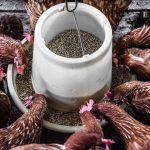
If you are looking for an alternative to feed for your chickens, consider whole grain. There are many options available to you, including oats, corn, and soy.
Contents
Oats
Oats are a source of fiber, vitamins, and minerals. They are also a good source of protein and antioxidants. But, they should not be given to chickens in large quantities. In fact, they can cause chickens to become sick.
When it comes to the benefits of oats, it is important to note that this crop is not generally fed to broilers. It is best to include oats in poultry feeds in small quantities. However, they are a useful winter treat for chickens.
The amount of beta-glucans found in oats has been shown to have a positive effect on chickens. These are polysaccharides that can fight disease and help stimulate the immune system.
Oat mash
In winter, when chickens need a nutritious treat, oatmeal is a great choice. Oats are rich in calcium and protein and are also a good source of B vitamins and antioxidants.
Whole oats should be mixed with regular chicken feed. They can be rolled, crushed or finely ground. Depending on the type of poultry, oats and barley should not be fed in excess of 15% of the diet.
If you want to prepare your own chicken feed, it is best to include all the essential ingredients. A local grain mill or feed store can provide you with basic grains. However, you can also purchase whole grains like wheat, corn, rye, sorghum, field peas, sunflower seeds, and more.
Oat pellets
Oats are the most digestible fiber in poultry diets. However, their inclusion in poultry diets reduces nutrient availability and dietary energy. Adding enzymes to oats can compensate for these antinutritional factors.
Poultry feeds with more than 25% oats tend to produce off-flavors in chicken meat. This is because oat hulls have a wide variety of nutrient contents. In addition, oats have high oil content. Using oats in replacement pullet diets reduces mortality, reduces cannibalism, and helps birds to resist heat stress.
Although poultry can be fed oats, they should not be used in breeding hen diets. Pellets are harder to digest and are best used in laying hen diets.
Soy
One of the most commonly used protein sources in the US animal feed industry is soybean. Soy is processed into oil, fiber, and protein. It is a staple in conventional chicken diets. However, its effects on poultry health have been questioned.
As a result of the controversy surrounding soy, several companies have offered soy-free chicken feeds. The resulting diets are being marketed to traditional chicken producers and those who want to produce their own birds.
A recent study examined the impact of a soy-free diet on the gut microbiome. This research was conducted on pasture-raised broiler chickens in the southeastern U.S.
Researchers collected samples at different stages of the production chain. They included fecal samples, cecal contents, and whole carcass rinses. They also performed 16S rRNA gene sequencing on the cecal contents and feces.
Corn
Corn is a nutritionally rich food, and is one of the most palatable treats for chickens. It is also a great source of fiber for their digestive system.
It is also a good supplemental feed. This means that you can feed it to your flock year-round. However, it is not as beneficial as other chicken feeds, and should only be a small part of your bird’s diet.
While it’s not harmful to feed your birds corn, there are a number of disadvantages. The biggest downside is that it is a fat-laden food that causes your hens to gain weight. Overweight chickens can develop heart disease and reduced egg production.
Methionine
Methionine is a sulfur-containing amino acid that is vital to the growth and development of poultry. It is involved in a variety of metabolic processes, including cell division and the production of proteins. The animal’s body can obtain methionine from natural sources or from a synthetic additive.
Many producers supplement methionine to water for the first 21 days after hatching. This allows the bird to get sufficient methionine to meet its daily requirements. In addition, methionine helps to improve egg production. However, if the bird is unable to produce enough methionine, it will have poor feed conversion and will suffer from retarded growth and egg production.
Two experiments were conducted to determine the effect of methionine on egg mass and feed conversion efficiency. Chickens were divided into four groups, each receiving one of two diets: the control diet or the diet that contained methionine.






